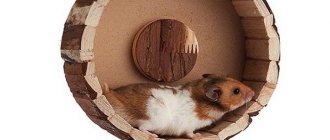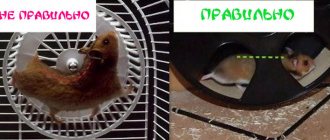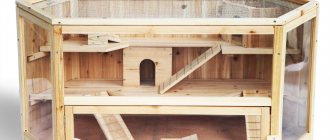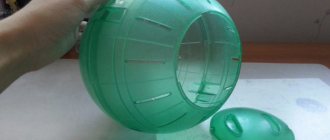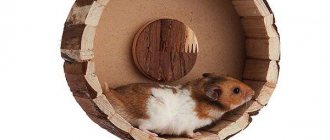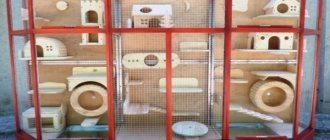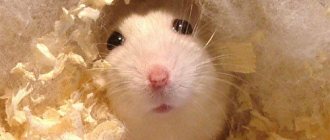Types of running wheels for hamsters
Hamsters of different breeds can be very tiny, from 4.5 cm to large individuals reaching 34 cm in length.
Accordingly, some are lighter, others are heavier. Depending on the type of your hamster, you should select a running wheel for your pet. Which wheel you choose for your hamster’s home will depend not only on its health, but also on its safety. Agree, if you buy a small wheel for a large hamster, and a huge one for a miniature one, then your animals will not be able to run on this simulator.
So the first thing you need to do is decide on the diameter of the running wheel.
For example, for Djungarian hamsters or for a Syrian baby, the diameter of the wheel should be a minimum of 14 cm and a maximum of 16 cm.
An adult Syrian hamster needs wheels more than 18 cm in diameter.
The track in the wheel must be of sufficient width. If its width is not enough, the hamster may fly out of the wheel. For example, for miniature dwarf breeds, a width of 5 cm will be enough, but for Syrian hamsters, the width of the wheel should be at least 7 cm.
The trainer should be the size of your rodent. If you have not chosen the correct diameter of the treadmill, then your baby will squeeze, stumble and get injured in the small wheel. It's hard for kids to run in a wheel that's too big. They have difficulty rotating it and, as a result, will stop using it altogether.
Not only the comfort of your hamster, but also the health of your pet depends on a correctly selected wheel. The consequences of incorrectly purchased running wheels can be sad. Spinal injuries, dislocations of limbs and even fractures are possible.
Running wheels are:
- plastic;
- metal;
- wooden;
- combined.
One of the disadvantages of metal running wheels is that they tend to squeak over time. Considering that your animal loves a nocturnal lifestyle, it will train in its wheel at night. Your sleep and a squeaky wheel don't go well together, would you agree?
The plastic running wheel is quiet and comfortable enough for a hamster to run. The main thing is that the treadmill has small ribs that the little athlete can cling to and not slip off.
Running wheels made from a combination of plastic and metal materials have proven themselves. The wheel itself is made of plastic, and the stand is metal. This is a silent and lightweight design with a reliable metal support.
Basically, lattice, mesh and wooden running toys for hamsters are common. If the wheel has a metal mesh, then the cells should be small so that the furry paws do not fall into them.
Important! The gap between the rotating working part of the surface of the simulator and the fastening of the wheel stand axle must be more than one centimeter. Otherwise, the hamster risks cutting off its leg, as the limb may get stuck in a narrow space, in which case the “scissors effect” is obtained.
The only negative is that from time to time the hamster can sharpen its teeth on its treadmill, but this will not cause any harm to its health.
Methods for attaching running wheels
- Hinged - screwed with special fasteners or ordinary wire to the cage lattice. This option is suitable for small cells. During hamster training, there may be sounds of the wheel tapping on the mesh of your pet's home.
- Floor-standing - these wheels stand on a floor stand and fit well into a spacious cage. The main disadvantage is that they are not entirely stable.
- On a stand with floor mounting - this method of mounting is more reliable. The stand attaches securely to the cage floor. This is the safest simulator.
Choosing the right cage
Buying an animal begins with purchasing an “apartment”. Let's figure out what a hamster cage should be like in order to balance the appropriate living space and meet the standards of a healthy living environment.
- Size. You need a cell of a certain area. Too small - all the necessary accessories will not fit inside; too large - the animal will feel discomfort.
- Base. The solid plastic bottom with rounded corners makes cleaning much easier, and dirt can remain in the pull-out tray.
- Rods. The ideal option would be metal, unpainted rods made of high-quality metal, with a frequent arrangement of cells. A hamster living in a cage with too wide openings between the bars will definitely escape.
- Door. Despite its small size, the animal is quite strong; the exit must have a reliable lock that the animal is not able to open or bend. If the cage has two floors, doors should be located on each. This will make it easier to clean and catch the animal if necessary.
If you first got a male, and then plan to get another female, you will need large housing. This is usually achieved by adding a second floor, rather than by having an impressive footprint. By purchasing such a cage, you can save money by not purchasing factory accessories.
Let's look at how to make the second floor of a hamster cage yourself. A lot of improvised items are used for production. The only condition is the absence of sharp parts that could injure the animal. It is necessary to make a platform and a ladder to it.
It is desirable that both surfaces are solid, without holes where a hamster's paw could fall through. Be sure to firmly fasten, or better yet glue, all the parts, because the animal is quite energetic and can knock them over or knock them over during play. The good thing about making it yourself is that you can fix a broken part without investing money.
You can also make nesting houses for hamsters with your own hands, where they store supplies, rest or sleep. To do this, you will need objects without sharp elements, with which you can create a cozy corner. Be sure to make several ventilation holes of small diameter so that the animal cannot crawl through them.
Where is the best place to place a hammock in a cage?
In order for the hamster to show interest and actively use the hammock for its intended purpose, it must be hung correctly in the rodent’s home. It is useful to consider the following points:
- Optimal height: the pet should easily climb into the hammock and get out of it without the risk of injury. A cradle located near the floor will often get dirty and interfere with the hamster's ability to move around the cage. Therefore, it is recommended to hang the product at a height of 5–10 cm from the bottom of the cage.
- Hammocks for hamsters should be placed where the animal likes to rest. The location should not coincide with the feeding or toilet area. It is best to place the bed on the second level of the home.
- The fastenings for the hammock are chosen to be reliable and durable: the bed should not move or turn inside out. The clamps must be universal and secure the product in any part of the cage.
- The owner should be able to easily remove the cradle if it needs to be washed or repaired.
You can make many accessories for a hamster with your own hands. A hanging bed in this regard is no exception. It will not only bring great benefits to the pet, but will also create comfort and decorate the house.
Intellectual games for rats
Gathering and scavenging are natural behaviors of these rodents and should be a regular part of their foraging pattern. A food puzzle is an easy way to develop this behavior.
But the market for rat food puzzles is somewhat limited. However, toys designed for other small animals can easily be used. Make sure the toy is the right size: small enough that the rat can't get inside and get stuck, or large enough that he can maneuver it easily once inside.
Supervise all interactions with food puzzles to ensure your rat's safety. Use only foods recommended by your veterinarian and be sure to measure portion sizes. To get your rat interested in a toy or food puzzle, you can cover the outside of it with something edible. Cream cheese and yogurt can be used in small quantities to entice your rat to play with the toy. However, keep in mind that these foods have no nutritional value and should not form a significant portion of your rat's actual diet.
And remember that the edibles served in the food puzzle should be considered part of your rat's daily diet to maintain his healthy weight.
Ideas on how to make a comfortable house for a hamster - diagrams, drawings and instructions
From plastic bottles
Option 1. To make a shelter for an animal from plastic bottles, you need 2 clean bottles of 1-1.5 liters, electrical tape, scissors and a stationery knife.
The neck and bottom of both containers are cut off, and the cut points are treated with electrical tape to prevent the occupant from being injured in the future. A hole is cut in one of the bottles exactly in the middle, equal to the diameter of the second.
The second container is inserted into the finished cutout of the first container; it should fit tightly. The resulting structure is secured with electrical tape.
Option 2. Such a house can replace a cage and will be like an aquarium with several compartments.
Several clean bottles with a volume of 5 or more liters are required. Each of the containers will represent a so-called room, so the number of containers used is limited only by the imagination of the master. You will also need a utility knife and scissors.
- The tops of the bottles are cut off. The height of future rooms should be such that the pet cannot climb over it and get lost in the bowels of the apartment.
- The necks are cut off from the remaining upper part of the bottles so that they look like funnels. You won't need caps for them.
- In the lower part of the container, almost at the very bottom, holes are cut, equal in diameter to the necks.
- All rooms are connected to each other through funnel necks.
In the video you can see what such an apartment looks like.
Does your pet live in a house made of natural materials? Poll Options are limited because JavaScript is disabled in your browser.
From cardboard
For construction you will need the most ordinary boxes of ready-made breakfasts or juice, scissors and a stationery knife.
All you have to do is cut the box to size and cut out the entrance.
If you use toilet paper rolls or paper napkins for construction, you will get an excellent labyrinth that rodents love so much. But you should take into account the size of the hamsters; for large individuals this type of entertainment is unacceptable.
From a box of paper napkins
For a simple construction, you will need one cardboard tissue box, stationery glue and a toilet paper or paper napkin roll.
It is necessary to remove all plastic elements and film from the future home. It is better to give preference to square-shaped containers; they can be cut exactly in the middle and you will get two ready-made houses that already have an entrance for the animal.
A toilet paper roll makes a great addition to your shelter. It is enough to glue it into the passage and it will be an imitation of a mink, which will obviously please the rodent.
From a plastic container
This type of container can be found in almost any home or purchased for a small amount in a store.
For construction you will need a food grade plastic container and a soldering iron.
- Using a heated soldering iron, the entrance to the house is cut out, and holes are made on the lid of the container for ventilation. This will help the pet feel comfortable in the home.
- Sawdust or any other bedding is laid out at the bottom of the house.
The advantage of such a structure is that it is convenient to wash, and it will also last longer than cardboard.
Wooden house
For construction you need:
- wooden board 1-4 cm thick;
- ruler;
- a simple pencil;
- circular saw or jigsaw;
- sandpaper;
- hammer;
- small nails.
Two parts 12.5 cm long and two parts 14.5 cm long are cut out and polished from the board. The height is taken arbitrarily, but it must be calculated so that the hamster can move freely.
A hole with a diameter of 6 cm is drilled (cut) in one of the 12.5 cm long blanks. Several small windows are made in different walls of the house for better ventilation. All cut holes are ground.
All parts are assembled using nails. You can use a square wooden sheet for the roof.
Mitten house
During the cold period, any living creature likes to bask where it is warm. Rodents are no exception.
During severe cold weather, it is enough to put a mitten that no one needs anymore in the cage. The hamster will instantly find a use for it and build his nest in it.
The downside of such a house is that it will most likely quickly acquire an unpleasant odor and wear out. Whether to replace it with a new one or not is up to the breeder to decide.
Coconut house
Due to its size, this type of housing is suitable only for Djungarian hamsters.
You will need:
- coconut;
- knife;
- hacksaw;
- sandpaper.
First, you need to drain the milk from the coconut by making holes in the eyes. Having stepped a couple of centimeters away from them, you need to tap with the handle of a knife; if a crack appears on the shell, then this part of the fruit is cut off with a knife, if not, then you should use a hacksaw. The pulp is completely cleaned. The cut edge is sanded with sandpaper.
How to arrange a place for a hamster
“My home is my fortress,” this is how the hamster treats his home. The rodent spends a significant part of its life in the house, resting, hiding from “danger,” and hiding food for a “rainy day.” It is up to the owner to help arrange this secluded place for the pet by choosing the most convenient design, covering it with sawdust, shavings, soft rags or napkins.
Note! You can choose a suitable house for your hamster at any pet store. The main thing is to ensure that the materials from which it is made are environmentally friendly and odorless
Otherwise, the animal will simply ignore its apartment, and the owner will feel sorry for the money and effort spent.
Plastic pet house
Some inexperienced hamster owners are wondering what material they should choose for a house. Today, houses made of plastic, wood, and ceramics are offered for sale. You can buy a home made of fabric. There are no specific recommendations on this matter; each material has its own advantages and disadvantages.
Plastic house
A plastic house for a hamster is the most common and affordable option. As a rule, those models that are presented in pet stores are made from high-quality materials and do not pose a danger to the animal. The variety of designs can satisfy even the most demanding esthete. Plastic houses are easy to maintain. They are easy to wash and, in addition, dry quickly. The price for this plastic product starts from 140 rubles*
However, some experienced hamster breeders note some significant disadvantages of such a hamster home. First of all, such plastic houses have poor ventilation.
For your information! A rodent may accidentally swallow plastic if it wants to taste the house.
Wooden house
Wood is one of those materials that a hamster has to deal with in its natural habitat. Your pet will certainly like a wooden house, as it perfectly retains heat, reduces noise and allows air to pass through. As for the aesthetic side of hamster housing, in pet stores you can purchase both inexpensive models that resemble a miniature doghouse and real masterpieces of wooden architecture.
Wooden house for a pet rodent
However, wooden houses have significant disadvantages. First of all, this concerns care. Wood is not very convenient to wash. In addition, it takes quite a long time to dry.
Note! Many hamster owners refuse wooden houses, arguing that wood absorbs a specific odor that is not so easy to eliminate.
Ceramic house
Ceramic houses for hamsters appeared on the pet supply market quite recently, but have already managed to win fans. This is primarily due to the wide variety of design options. Hamster dwellings in the form of pumpkins, pieces of cheese, forest huts and stone grottoes can appeal not only to the hamsters themselves, but also to their owners. Especially if the pet's owners are children. In addition, ceramic houses are environmentally friendly and easy to maintain.
The disadvantages include the high cost of this product and the fragility of the design. Therefore, when sanitizing the cage, care should be taken to ensure that the cage does not fall.
Important! Unfortunately, after damage to a ceramic house, reuse is not permissible, since the glue used to glue the fragments together can be toxic to the pet.
House made of vines
Some species of hamsters, such as dwarf hamsters, like to live in a house made of wicker. It will not absorb odors, is excellently ventilated and, moreover, closely matches the natural conditions for a hamster.
Unfortunately, such houses can rarely be found on the shelves of pet stores, and they are expensive. In addition, over time, such a house can be significantly damaged by the occupant of the home. Some hamsters can sharpen their teeth on bars.
Wicker house for a hamster
Quilted houses made of fabric and padding polyester
Recently, houses for hamsters made of fabric and padding polyester have been gaining popularity. This is a good option because if it gets dirty, it can be easily washed and dried quickly. In such a home your pet will feel warm and comfortable.
Note! This option can either be bought at a pet store, or you can sew it yourself from scrap leftover fabric or disused shirts.
Toy options for hamsters
With the appearance of a small rodent in the house, owners begin to be interested in a lot of completely new questions for them. Is it possible to bathe a hamster? Should you give your rodent meat? What toys does a hamster need? Regarding the latter, we have prepared a small list of possible options. It can be:
- Stairs.
- Swing.
- Houses.
- Labyrinths.
You can get acquainted with a wide range of products at any pet store. As a rule, there is quite a large selection there. But the cost of toys is not always affordable for buyers. However, this is not a reason to deny your pet toys. You can...make them yourself. And we will tell you how to do it correctly and quickly.
How to set up a play area for a hamster
The playground can be equipped outside the cage. To do this, combine several cardboard boxes so that you get a space enclosed on all sides. Check the security of the structure to prevent your pet from escaping.
Lay out toys for hamsters and safe household items. Install swings, slides, plastic flower pots, wheels.
Buy a special walking circle for your hamster so that the animal can move around the apartment without risk.
Keep track of which game your pet likes best. The most favorite toys can be bought or created in several copies to place them in a cage or on the playground.
Making simple tunnels
A hamster cage must contain at least one small tunnel. And for games outside the home, complex structures of medium and large size are suitable. You can make a permanent entertainment room for your furry friend or build the attraction anew each time, changing its size and direction of moves.
Children are showing great interest in creating entertainment for hamsters. We invite you to study the instructions for creating simple tunnels that even a schoolchild will understand.
Paper tube for cage
The simplest option is to use a cardboard paper towel tube as a building material. You can put it in the cage unchanged or make windows in the tube so that the animal can come out through them.
The sleeve tube can also be installed in external cardboard labyrinths.
Game room
Do your kids love to play with and watch hamsters? Then give them an idea: make a tunnel for a hamster from an unnecessary cardboard box. The kids will happily get down to business, use their creative imagination and create an attraction with love.
There are a lot of construction options. We will tell you how to make a hamster maze in two different ways.
- The first method does not involve the use of glue. Take a box and pieces of cardboard: 3 strips should correspond in size to the length of the room, 5 to the width. On long pieces, make 5 cuts at equal distances from each other, and cut short pieces three times. Between the cuts, cut out doors, windows and holes for pipes. Now we can assemble our room. Install long partitions with the cuts up, and insert short parts into them with the cut down. You will get a lattice. If you have pipes planned, insert them into the round cutouts. Place the grid in the box and you can start playing right away!
- The second method is based on gluing the walls. It is good because you can create a variety of branches, as well as a rest room for a small creature. To glue the walls, use regular or construction tape.
Labyrinth from a construction set
Preschoolers and schoolchildren love to build various castles and fortresses from construction sets. Invite them to make an attraction for a hamster - they will happily complete this task. Moreover, children themselves know how to make a labyrinth for a hamster from Lego constructors interesting and convenient.
If you are building a walker for a dzhungarik, small parts are better suited. For the larger Syrian breed, use medium sized pieces. Using a small construction set inside the maze, you can build a small obstacle course for the animal, at the end of which you can place a tasty nut.
Book fortress
Old hardcover books are suitable for creating a large, spacious tunnel. To do this, they need to be placed with their roots facing up. It is better to completely enclose the space with books so that the hamsters do not run away in different directions. For one animal, the width of the passage can be 5-8 cm (so that the animal can easily turn around in it), but if you have several fluffies, the tunnels should be more spacious.
In such a book fortress, kids really love to have hamster races. Rodents are placed in a common closed room, after which they open the “door” and watch which of the animals gets to the exit first
At the same time, it is important to ensure that race participants do not violate the rules. If a cunning hamster climbs over the wall, he must be brought back. A maze made from books can also be used to train animals.
To do this, you need to place small pieces of tasty food along the chosen path, and repeat the operation several times with the same route. Then you should place the treat only at the exit. You will be surprised how quickly your smart hamster will find it!
A maze made from books can also be used to train animals. To do this, you need to place small pieces of tasty food along the chosen path, and repeat the operation several times with the same route. Then you should place the treat only at the exit. You will be surprised how quickly your smart hamster will find it!
Tunnel made of plumbing parts
If your apartment has recently been renovated and you still have unnecessary parts for connecting pipes, use them to create a branched labyrinth! This attraction is suitable for both small Djungarian and larger Syrian and Caucasian hamsters. By the way, the tunnel made from plumbing looks very original. Another advantage is the collapsible design of the attraction, which means you can periodically change the direction of the moves.
Making it is very simple: connect the parts in any direction. It will be more interesting for the hamster to play if there are several exits in the pipe. But in this case, do not leave the home unattended, otherwise you will have to look for it throughout the apartment!
Making complex adventure games
Young children will not be able to make complex tunnels for hamsters with their own hands; they will definitely need the help of adults. But teenage boys will cope with the task with a bang!
Tunnel made of plastic bottles
Plastic soda and juice bottles are found in every home. But not everyone knows that they can be used to make a tunnel for a hamster. For this purpose, containers with a volume of 0.5 liters are better suited. If the rodent cage is the place where the tunnel will lie, then only 3-4 bottles will be needed. For an external attraction, you can choose any quantity. All bottles should first be freed from labels and washed thoroughly so that they do not smell.
When building a bottle attraction, follow the plan below:
Trim the top and bottom to create a cylinder. A stationery knife is better suited for this purpose. There will be sharp burrs on the bases of the cylinder, which can injure the fluffy, so they must be masked. To do this, cover the sections with electrical tape. Cut round holes in two cylinders of equal diameter
It is important that the size of the circle matches the diameter of the bottle you will attach to it. Cover the edges with electrical tape. Now prepare the parts that will act as branches
One of the ends of the bottle must be squeezed and the corners cut off at a slight angle. When you release the bottle, it will straighten out, and the cut will acquire two smooth notches, thanks to which the part will fit tightly to the cylinder with the hole. We do the same with the second bottle. Don't forget to tape the edges! Now it's time to make 2 T-shaped connections. Place a bottle with a wavy edge against the hole in the cylinder, wrap the connection with electrical tape, and then wrap the supporting part. To make the structure more durable, repeat this operation twice. Now fasten the T-shaped connections together with the same electrical tape. The bottle maze is ready to use!
Wooden labyrinth
If you are patient and careful and have woodworking skills, try making a hamster tunnel with your own hands from wood. Sanded boards or plywood are suitable for this purpose. This attraction is safe for hamsters; they will happily run along the intricate passages.
A wooden tunnel can be made large in order to play with animals there and organize hamster races. If cage space allows, install a three-tier wooden labyrinth for your pets. Of course, you will have to work hard cutting out windows and stairs, but your pet will be happy. When creating such a small attraction, it is better to use special wood glue rather than nails.
Now you know how to make a tunnel for a hamster with your own hands, using available materials that are always at hand. By building a room with partitions for your touching furry, you can not only play with him, but also develop your pet’s intelligence.
Step-by-step instructions: how to make a labyrinth?
From plastic bottles
Now we’ll learn how to make a maze for a hamster with your own hands from plastic bottles. As it turns out, they can be used to make a whole gallery of multi-level tunnels. The configuration of the labyrinth can be simple, or with dead ends, and even multi-level. For the simplest play structure with 2 knees you will need 3 plastic bottles. Conventionally, they can be designated as:
- Entrance corridor.
- Passage corridor.
- Dead end.
You need to wash the bottles and remove the stickers from them. Cut off the bottom of the inlet bottle. Through this hole the hamster will enter the maze from his cage. The cut line should be free of notches and burrs. Cover the cut with electrical tape or tape so that the sharp edges do not injure the nimble animal.
In the part of the bottle where the narrowing towards the neck begins, 2 holes are cut out opposite each other with scissors: a small hole with a diameter slightly larger than the cap and a large one, almost equal to the diameter of the bottle. To cut a circle, first use a knife to make a cross-shaped slot into which you can easily insert scissors.
In the tapering part of the second - passage - bottle, make a round hole smaller than the diameter of the bottle. Cover the edges of all cuts with tape or tape.
Insert a pass-through bottle through the large hole so that the cap comes out the other side. The parts should form the letter “G” or, in other words, a knee. In the same way, neck to neck, attach the third bottle - a dead end.
If you want your hamster to have a treat at the end of the maze, make a hole at the top of the dead end where you can insert a funnel and pour treats through it for your pet. A homemade funnel can be the cut off neck of a bottle with the cap unscrewed. The connections of the parts are firmly fixed with tape.
Made of wood and plywood
A portable labyrinth is constructed from wood and plywood. For this you will need:
- Planks.
- Plywood.
- Glue.
- Wood saw.
The base can be cut out of plywood. If a plastic box is chosen as the basis for the labyrinth, then it is better to sprinkle the bottom of the labyrinth with sawdust or sand so that the animal does not slip. The height of the walls of the base should be sufficient to prevent the hamster from climbing outside.
- Make the base of the labyrinth - the floor and outer walls.
- Place the boards inside so that they form an intricate labyrinth.
- Cut holes in some walls for a through passage.
- Glue the planks to the floor and base walls with glue.
- Make some of the galleries covered - rodents love dark holes.
- Allow the structure to dry from the glue.
From cardboard
The labyrinth is made from cardboard in the same way as from planks. The parts of the product are cut out with scissors and attached to the base with tape.
Shoe boxes, toothpaste boxes, etc. are used to make interior walls. Place them inside a large base, cut random passages of an interesting configuration in the walls. Glue with glue or tape.
From toilet paper rolls or paper towels
Rolls of toilet paper and paper towels make interesting tunnels. Such tunnels are located between boxes inside the structure, making it more similar to a hamster's home in a natural environment. Paper sleeves are attached with tape or glue.
From a children's construction set
You can make a labyrinth of any complexity using a children's construction set. Build a playground with bridges, galleries and obstacles. Add a staircase and a second floor. Don't forget to design a compartment where your pet will have a treat.
From plumbing pipes
Plumbing pipes can be used both as separate tunnels inside the box and as material for the manufacture of an entire structure. This is a durable material that even has factory connections - fittings. Make a structure of any complexity from pipes. Make small holes for ventilation in the product.
Therefore, ventilation can be made in the form of longitudinal slits or a series of small holes in the pipes. This way you will have windows for observing the little traveler.
A ready-made hamster cage with a labyrinth will save you from the need to regularly walk your pet. Such products are sold in stores, or equip the cage yourself with a tunnel made of durable material. Please note that a hamster is capable of chewing even the most durable plastic of factory products. Therefore, regularly check the integrity of the structure.
Finished cage with labyrinths
Pet stores offer customers cages for hamsters with ready-made labyrinths. The cost varies between 1.5-5 thousand rubles.
How to choose
When purchasing sports equipment for your pet, you need to consider:
- Age and activity of the animal. For small and elderly animals, it is better to buy a cage with a short tunnel, with a minimum number of obstacles. For mature and healthy hamsters, the sports complex can be equipped more complexly.
- Pet sizes. The passages should not be too narrow. Large tunnels are also not suitable, since the animal will not understand that it needs to run forward and not just sit.
- Construction material. Plastic and wood are a good solution, but these materials will also be tested for strength by the sharp teeth of a rodent. Metal structures are the strongest and most durable. It is best to buy a sports complex made of this material.
How to make a ball for a hamster from bottles with your own hands
If you don’t want to waste money trying to determine whether your hamster will like the walking sphere or not, you can make it yourself. This will require just a few available materials, perseverance and a little resourcefulness.
Let us further analyze the main stages of manufacturing a device for walking domestic rodents.
What you need
In order to make a walking ball for a hamster, you do not need specialized materials or expensive tools. It is enough just to look around or, as a last resort, visit the nearest supermarket.
DIY walking ball for hamsters: video
So, for these purposes we need the following:
any round container with a tight lid and sufficient diameter (for dwarf hamsters, etc. about 12 cm, for larger species about 18 cm, for the largest hamsters about 30 cm)
Its role can be played by plastic containers for dairy products or other goods, and it is important that the diameter of the lid allows the rodent to freely penetrate inside the container; an awl, stationery or sharp kitchen knife; sandpaper P150 or P180;
detergent.
Important! It is not recommended to use containers containing toxic or flammable materials for the manufacture of walking spheres, as they can cause severe poisoning of the rodent.
Self-production
Once you have acquired all the necessary materials and tools, you can begin creating your first walking ball for your beloved hamster. Making the device does not require any special skills, so even children can trust it, or turn it into an exciting family adventure.
The process consists of the following steps:
- Remove all stickers from the container and clean its outer surface of any glue residue.
- Wash the container thoroughly with detergent and dry naturally;
- Make ventilation holes in the vessel. To do this, use an awl to create the maximum number of small holes, or use a sharp knife to make several small oblong holes measuring 0.3 cm x 4 cm.
- Sand any sharp edges of the holes using sandpaper.
Your ball is ready, now you can happily use it to walk your pet hamster. By following all of the above recommendations, in just a few minutes you will be able to create a durable and reliable structure that will delight your pet for many months.
A walking ball is one of the few truly important accessories for keeping a pet rodent. After all, the device makes it possible for the animal to maintain the necessary athletic shape, as well as tone its body.
However, when choosing one, it is necessary to determine the correct size, since only in this case will the hamster walk in the ball be as safe as possible for its health.
The need to create a cozy environment for the hamster
Despite the fact that a hamster really looks like a fluffy toy, in fact it is a very fragile creature that needs careful treatment and care.
The rodent's body is very delicate and can be easily damaged. You should definitely talk about this with your children in advance.
With a sedentary lifestyle, Djungarians are prone to obesity. That is why pet stores offer a wide range of different accessories that make animals move more. These are various labyrinths, tunnels, stairs, swings, running wheels. However, you can also make all sorts of things for hamsters from cardboard with your own hands.
Most often, DIY hamster crafts are made for 2 purposes:
- stimulating animal activity;
- search for treats.
The dimensions of the crafts must match the animal so that it can move freely without getting stuck between the structural elements.
Examples of ready-made cardboard crafts
Options for ready-made homemade products will help you choose an interesting idea of what can be made from cardboard for a hamster, how to decorate your pet’s home in an interesting way, design toys and objects that encourage the hamster to be active.
- a maze for a hamster made of cardboard with built-in ladders, tunnels, and slides.
- Running wheel made of corrugated cardboard.
- A two-story cardboard house for a hamster, made using decorative paper.
- Balls made from cardboard tubes with treats inside.
- Tunnels made of bushings with slots for active crawling and searching for food.
- A small cardboard house that looks like a real one.
What toys does a hamster need?
Before you start making attractions, it is important to examine the animal’s apartments and figure out where and what kind of toy is best to attach. When the division of free territory is over, we decide on the necessary entertainment complexes
Without a doubt, first of all, the furry furry’s living space should be equipped with a house. Do not forget that the hamster is a nocturnal animal. The presence of a kennel will allow the animal to hide from sunlight, and nothing will disturb its sleep.
The next point worth noting are toys designed for grinding teeth. Rodents are happy to chew anything that comes their way
To prevent the cage from wearing out prematurely, thanks to its furry assistant, it is important to equip the hamster’s territory with sticks and branches of fruit trees. This way the animal will have something to chew, and the bars of the cage will not arouse much interest.
Don't forget about running gear. Ladders, balls for walking around the house, wheels - exactly what you need. And intricate tunnels and passages with obstacles will help to further diversify your furry baby’s leisure time. Whatever your imagination comes up with won't hurt.
What can you do for your pet yourself?
The hamster is an extremely versatile pet, since it does not require too much space to keep it, and entertainment devices can easily be constructed from what is found in every home. So what should we make ourselves?
- Cell. Build with your own hands both a temporary and permanent home for the rodent. All you need is wooden rods for the frame, plywood for the bottom and a metal mesh, preferably small, so that the baby doesn’t run away on housewarming day.
- Drinking bowl. At first, a plastic bottle and the body of a ballpoint pen can easily cope with the task of such a device.
- House. To build such a structure, almost anything your imagination desires is suitable: from a plastic box to a clay vessel.
- Homemade toys and accessories for “sports” for hamsters. There are no restrictions. Make anything you want that fits in your hamster's apartment.
Of course, the list is far from complete. Make whatever you want. The main thing: do not forget - the devices should not harm the fluffy .
Useful video
Do you want your hamster to remain cheerful and agile? Do you want him to never get bored? Do you want to provide him with every opportunity for physical and mental activity? Like the one that wild hamsters get during their nocturnal adventures?
Then it is necessary to provide your pet with interesting activities, both in the cage and outside it - on the playground.
Go to a pet store and browse the sections that sell hamster supplies. You will see a wide variety of toys and entertainment equipment. You'll find wooden molds with holes for the Syrian hamster, grass and bamboo balls and grass tunnels for the hamster to hide in and chew on, as well as colorful cars, shoes, trucks and planes for the hamster to climb on or crawl inside. The question arises: with such wealth, how can you choose what your hamster will like? Will your golden hamster climb stairs or swing on a swing, will it go into a prefab or grass tunnel, a rocket or an airplane? Unfortunately, it is impossible to predict for sure which toys he will like and which he will not. But fortunately, toys for hamsters are usually not very expensive, so a toy rejected by your pet won't cause much damage to your budget.
Please note that all animals are very different. For example, Goldn likes variety in her life and can very quickly lose interest in a toy that she has already explored hundreds of times. Even the best toys can become boring if played with for too long. (Isn’t it like that with us?) Therefore, constantly offer new toys to your pet, put away the old ones and after a while put them back. Or combine and rearrange old toys to give them a new twist. That is, do whatever you want to make life interesting for your hamster.
And don't forget to inspect your toys regularly. Check to see if they have become unusable or chewed. Don't be sorry, throw away any overly chewed toys if you think they are unsafe for your hamster's health.
Spin, spin, wheel.
The first thing you will notice on the shelves of a pet store is the abundance of hamster wheels. Almost all hamsters enjoy running on a wheel; no training is required. Revisiting the “Wheel Activity” in Chapter 5 will help you decide on the right wheel and help you remember information about how to use them and the problems that arise.
Tubes and tunnels
Please note that there cannot be too many tubes and tunnels. After all, in the wild, hamsters spend their days hiding and sleeping in a labyrinth of underground tunnels. So if you don't have a cage system with connecting tubes, it might be a good idea to build an obstacle course on your playground. Attach straight and right-angled plastic tubes to spigots, tees and six-hole cubes to create an interesting labyrinth. Fortunately, you don’t need to purchase everything at once; you can build such a labyrinth, piece by piece. And to keep Goldn always interesting, rearrange the sections more often, creating new configurations.
Examples of games with hamsters
Games with a hamster are quite varied and will bring a lot of pleasure not only to the owner, but also to the pet.
In a cage
There are many options for playing with animals. All that depends on the person is to provide the necessary toys:
- Wheel. In their natural habitat, rodents run several kilometers per day. But in a cage they do not have this opportunity, so the presence of a wheel will diversify the hamster’s life and give it the necessary exercise. It is better to purchase such a product at a pet store.
- Tunnels. Animals simply love to climb on them and explore the new space around them. Rodents enjoy this activity doubly because their natural homes are burrows. The tunnels differ only in their volumes and the area they occupy. To compensate for the deficiency, you can build them in the form of labyrinths, and put any food at the end of the path. The hamster will definitely enjoy going through obstacles.
- Swing. Used as an option to develop a sense of balance in your pet. Externally, the structure looks like a wooden board, and underneath it is a round block. There is a hamster on one side and a treat on the other.
- Stairs. One of the most popular entertainments. Various slides and slopes are suitable to “release” the energy accumulated during the day. But you should be more careful, since hamsters are rodents, so they will “try” their toys. When purchasing, you need to make sure that the latter do not contain any chemical toxins or substances.
Outside the cage
You can move on to games outside the rodent shelter only with those pets that have adapted to the owner, are used to being in his arms and climb on them themselves.
The owner will not only provide the animal with an entire region for research, but can also increase the size and variety of playing grounds.
For example:
- A walking ball is the most popular way to allow your rodent to explore a room. With such protection, the animal can not only roam around the house safely, but small children can also handle it. In addition, the animal is also not in danger of falling from a height or hitting corners.
- Cardboard maze. This is a larger version of the caged design. Here you can show your imagination. Curls, dead ends, secret passages - how many things an owner can build for his baby. And the pet itself will be quite interested in exploring the new object. There are more places to place food here, you just need to put in a little creativity. However, you need to be careful - the animal can easily get out of the maze, so it is better not to turn away from the hamster while playing.
- Transformable tunnel. The parts of the structure can be used to create a creative, complex and exciting path from one end to the other. But the most important thing is that after the animal goes through the maze for the first time, it can be reassembled with new forks and dead ends.
- Ball or tennis ball. You can build a small pen for the rodent, which looks like a football field. Afterwards, you should release the “player” there and give him a round object - an improvised ball. The pet will immediately start playing with it, chasing it from side to side. It turns out to be a kind of football, albeit with one player.
Games without devices
The easiest way to entertain an animal without much effort is to jump from hand to hand. This option will get the hamster in good shape, add some entertainment to his life, and perhaps be able to replace the wheel.
You can try giving your pet an ordinary napkin and see what happens to it after a few minutes. The hamster will begin to gnaw and tear it.
You can also sit your pet on the sofa. An unfamiliar place will immediately interest the animal, the animal will begin to run and explore the territory. If your pet falls asleep on the sofa, you should cover it with some fabric - this will create the atmosphere of a hole.
Hamster toys
Hamsters in nature are forced to spend a lot of time searching for food and fleeing from predators. They don't have time for special games. In captivity, animals often become overweight due to their conditions: small cages and insufficient equipment.
Therefore, in order to create ideal conditions for animals, it is necessary to properly equip the cage and fill their leisure time with special devices. Since it is unwise to put hamsters in danger by having a predator, toys should work in two directions:
- searching for food;
- physical activity.
For the first, grass balls in which a treat is buried, various types of sandboxes and structures with seeds inside are suitable.
Water activities for rats
Pea fishing is a great water game for rats. Place a cloth in the entertainment area, then take a bag of frozen peas and place a handful in a shallow ceramic or glass bowl of cool water. Add some large, smooth rocks for your rat to climb on. Show the rats their new pool. Now you can watch them jump into the water and dive for peas, or sit on the edge playing with the peas with their front paws, or just lie in the water and eat the peas they retrieved.
Your water-loving rats will love the opportunity to swim and snack at the same time. And those who are afraid of water will be able to sit calmly on a rock or on the edge of a pool and catch peas floating by.
Homemade toys from waste
Even real garbage can be used as starting materials for toys. The main thing is the quality of the product, so that the hamster becomes interested in it and does not break it when it starts playing there for the first time.
Walnut shell toy
To create such a toy, you need several walnut shells and threads of the length that the resulting thing should be. Instead of thread, a thin, strong rope will do.
Next, you need to take a hammer and a nail, with which you make a hole in all the shells. Walnut shells have a structure that makes it easy to punch a hole in it without it breaking into pieces. It is advisable that an adult handle this task, otherwise a child who decides to make a toy for a hamster may accidentally hit himself on the finger with a hammer. A thread is threaded through the punched holes until all the shells fit onto it. In this case, it is better to make sure that the thread is hammered in tightly enough and does not dangle too loosely. To prevent the shell from moving off the rope, a washer is attached to one end, and the other end is tied at the top of the cage.
To help your pet start playing sooner, you can put his favorite treats inside the shells. Such a thing performs three useful functions at once: it allows the hamster to grind its claws, develops intelligence and simply helps to kill time.
Design requirements
Compliance with the technical requirements when making your own labyrinths for hamsters is of great importance:
- Freedom and space: Hamsters should feel relaxed in the maze. There should be no crowding, due to which the pet would not be able to turn around inside the complex, or other insurmountable obstacles on the way.
- It is mandatory to have ventilation in long tunnel systems for hamsters: for this, holes are made in different places of the labyrinth or the roof is removed. An animal can get too playful and stay in the pipes for a long time. And in the absence of fresh air, discomfort will inevitably appear; the hamster may even suffocate.
- High and steep descents and ascents are not allowed - a small rodent may be injured. Hamster labyrinths increase in width and length, but not in height.
- For babies or old rodents, the structure becomes more primitive; for mature and active hamsters it becomes more complicated - new holes and passages are added.
- Hamsters love to chew on everything. Therefore, the integrity of the structure must be monitored, especially if it is made of flimsy material, such as cardboard.
- All adhesives should remain outside the corridors and the pet should not have the opportunity to eat them. It is also required to use only non-toxic, odorless types of glue during construction.
- The hamster labyrinth must be disassembled so that you can monitor its cleanliness.
- It is better to connect the device directly to the animal’s cage. This way the hamster will feel safe and can climb into the tunnel whenever he wants.

